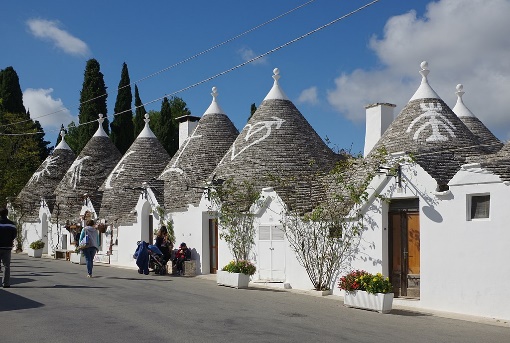
I Trulli

Trulli di Alberobello (foto di Berthold Werner, CC BY-SA 3.0, https://commons.wikimedia.org/w/index.php?curid=60159414)
Il trullo, lontano erede del modello costruttivo squisitamente mediterraneo del thòlos, con la sua riconoscibile forma tronco-conica, è una costruzione realizzata a secco che nasce dalla sapienza e dall’ingegno contadino. Per rendere coltivabile il pietroso terreno calcareo della zona, gli agricoltori erano costretti a rimuovere gli abbondanti strati di roccia presenti nel suolo e decisero di utilizzarli come materiale da costruzione. Anche il viaggiatore moderno quando arriva ad Alberobello ha l’impressione di trovarsi in un luogo fuori dal tempo e in una dimensione magica, eppure queste costruzioni sono relativamente recenti e nascono, non tanto dalla magia, ma per ragioni ben più pratiche, ad essere precisi per ragioni di natura fiscale! I trulli della Murgia pugliese sono indissolubilmente legati alla fama e alla leggenda nera del conte di Conversano, Gian Girolamo Acquaviva d’Aragona, conosciuto come il Guercio di Puglia. Il temuto feudatario, noto per la sua spregiudicatezza e per una politica molto ambiziosa, amministrava nel XVII secolo questi territori in nome dei Viceré spagnoli. Vuole la tradizione locale che il conte, avido di profitti, contravvenendo al divieto regio di costruire nuove città, avesse permesso l’edificazione dei trulli, per meglio sfruttare le risorse agricole di quei terreni e il lavoro dei contadini. Si racconta che in occasione delle visite regie di controllo, il Guercio facesse abbattere in tutta fretta i coni, costruiti a secco e quindi facilmente demolibili, per poi farli ricostruire, non appena ‘l’accertamento fiscale’ spagnolo fosse concluso.
Una delle caratteriste dei trulli è che ognuno reca in cima, oltre ad un pinnacolo scolpito, anche uno strano disegno, si tratta di simboli di diversa natura, alcuni rimandano a millenarie tradizioni pagane o esoteriche, altri invece alludono all’iconografia cristiana. Vengono realizzati con il latte della calce direttamente sulle chiancarelle, cioè le pietre che compongono il cono del tetto. Questi disegni servivano non solo a distinguere le famiglie proprietarie dei trulli, ma assunsero una valenza apotropaica, si credeva che allontanassero il malocchio e propiziassero un buon raccolto. I simboli più comuni e facilmente riconoscibili sono: il candeliere ebraico, il simbolo del Sole-Cristo, il cuore trafitto di Maria che allude alla Passione. Altri simboli pagani molto comuni sui trulli di Alberobello sono quelli del Toro, di Giove e di Venere.
